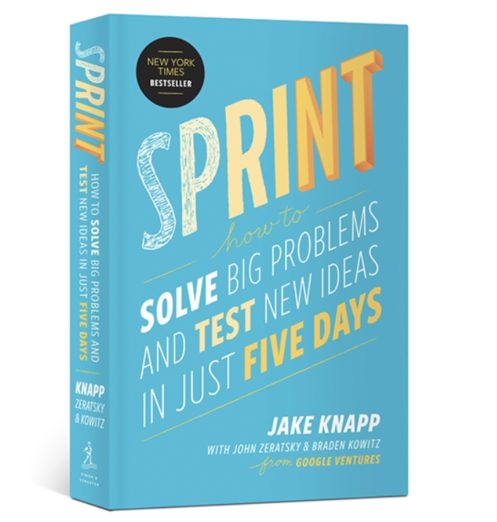
필자가 한국 스타트업을 만나면 항상 반복해서 해오는 비판이 하나 있다. 어떤 일을 실행에 옮기기까지 걸리는 시간 말이다. 원인은 여러 나쁜 습관에서 기인할 것이다. 가령 사업 초기부터 큰 규모 팀을 보유해 달랑 2명이 일하는 팀과 견주면 의사 결정에 훨씬 많은 시간이 걸리는 점을 들 수 있다.
또 대부분 완벽주의를 지향하기 때문에 정식 론칭에 앞서 제품에 대한 모든 기획과 계획, 완성과 테스트가 내부적으로 끝내야 한다고 믿는다. 이런 모든 요소는 제품 개발이 수개월에서 1년도 더 넘게 걸리게 만든다. 그 탓에 제품을 출시해도 이미 세상은 바뀌어 있어 성공 기회를 놓쳐버리게 되는 것이다.
그렇다면 얼마나 빨리 움직여야 하는 걸까. 아마 생각보다 훨씬 더 빨라야 할 것이다. 스프린트, 전력질주라는 개념은 첫 제품을 설계에서 구현하는데 5일 내에 이뤄낼 수 있어야 한다고 주장한다. 그렇다. 시작부터 끝까지 5일이 걸린다는 얘기다. 그야말로 전력질주라 부를 수 있다. 그렇다고 해서 이 말이 보통 1년이 걸릴 일을 5일 안에 끝내라는 의미는 아니다. 무언가를 5일 안에 만들 수 있도록 목표를 잡자는 뜻이다. 그리고 이를 통해 실사용자로부터 이 제품이 시장에 적합한지 또 문제는 무엇인지를 현실적으로 파악할 수 있게 된다. 이건 아마 많은 한국 스타트업이 마주한 문제에 대한 해결책이 될 수 있다.
스프린트 개념의 핵심은 중요한 것에 초점을 맞추라는 것이다. 제품 출시 이후 실험실 밖으로 나와 현실 세계를 마주하게 되면 그 세계는 뭔가 상황이 다르다는 것이다. 생각했던 고객 니즈와는 다르게 뭔가 다른 걸 원하고 있을 수도 있다. 또는 화이트보드나 컴퓨터로 그려둔 기술적 문제가 실제 생황과는 다를 수도 있다. 한마디로 시뮬레이션과 현실은 다르다는 얘기다.
그럼 스프린트 방식은 과연 유효한 걸까. 실제로 아이디어의 빠른 검증을 위해 이 스프린트 방식을 써왔던 슬랙이나 네스트, 23앤미를 비롯한 수많은 스타트업에게 물어보라. 필자 역시 이 방법론을 이용해 아이디어를 실제로 구현해보고 제대로 작동하는지 확인해봤다. 1년을 기다리는 것보단 5일만 투자해 아이디어가 정말 작동하는지 확인할 수 있다는 말이다. 놀랍지 않은가.
이 방식의 유일한 문제는 한 번에 대중을 향해 출시할 수 있는 버전이 나오지 않는다는 것이다. 따라서 스프린트 이후 다음 단계 일에서도 여전히 빠른 속도로 질주할 수 있도록 신경 써야 한다. 그리고 이런 식으로 해결책을 찾아 제품을 테스트하게 된다면 제품 론칭을 몇 달이 아닌 몇 주 내로 진행할 수 있게 될 것이다.
명심해야 한다. 에어비앤비다 와이콤비네이터에 지원했을 당시 창업자 2명이 아이디어 하나만으로 시작했다는 걸. 이들은 그 후 몇 달 뒤에 진행된 데모데이에서 실제로 작동하는 첫 제품을 선보여 첫 라운드 펀딩을 받을 수 있었다. 그럼에도 여전히 창업자 2명만으로 완성 제품을 고객에게 서비스했다. 절대 극단적인 예가 아니다. 빠르게 성장하는 스타트업은 보통 이런 방식으로 시작했기 때문이다.

스프린트는 책으로도 읽어볼 수 있다. 저자는 모두 구글벤처스 출신이자 이미 성공을 거둔 사업가로 이들의 업무 방식이 자세하게 설명되어 있다. 흥미로운 사실은 이들 저자는 실제 책을 집필하는 과정에도 스프린트 방식을 적용했다는 것이다. 인터넷에 90초 만에 스프린트 개념 이해하기를 한 번 검색해보면 알 수 있다.
이 글을 읽고 있는 독자가 글로벌 진출에 관심이 있는 한국 스타트업이라면 이 글을 개인 초대장으로 여기고 연락을 줘도 좋다. 페이스북이나 트위터(@aviramj), 이메일 주소(aviram@jenik.com) 뭐든 좋다.
Don’t just run, sprint
One of my repeated criticism to Korean startups I meet is how long it takes them to move; it stems from many bad habits: Korean startups often have large teams even in a very early stage, which makes everything from decision making to development take much longer than it would have taken with just 2 people. Korean startups also tend to be “perfectionists”; everything needs to be designed, planned, finished and tested internally before the launch. All this means that product development takes months – often more than a year. By the time you launch, the world has changed and you may have already missed your chance.
How fast should you go? Much faster than you might think. A new concept called “sprint” claims that you should be able to design and implement an initial version within 5 days. Yes, that’s a total of 5 days from start to finish: a real sprint. The idea is not to finish in 5 days what you would ordinarily do in a year – but rather to give yourself a target to launch “something” within 5 days. Once you launch, you can see real customers react to verify product-market fit and get a realistic assessment of what your real problems are. This may be the solution to many issues Korean startups are facing today.
The idea of a ‘sprint’ is to have you focus on what’s important; once you launch, you get out of the laboratory and into the real world; things are different in the real world. Customers often want things that are different than what you think they want. The technical problems are often different than the ones you thought when you were drawing the design on the whiteboard or on your computer. In other words: reality is different than the simulation.
Does it work? Ask slack, nest, 23andme and dozens of other startups that have used the sprint methodology to quickly test their ideas. I have used this methodology myself, launching ideas immediately to see if they work. Instead of waiting a year to pivot, you can see if your idea works in just 5 days. Amazing, isn’t it?
The only problem with “Sprint” is that it does not finish with a product you can launch to the public. So make sure your next step after “Sprinting” is still to run fast; once you have selected the solution and tested the product you should aim to launch in weeks, not months.
Remember – Airbnb applied to YCombinator with a team of exactly 2 people and nothing but a general idea. They finished an initial working product by the “demo day” which was just a few months later, and got their first funding round a little bit after that, still with 2 people but with a finished product that was already launched and started serving customers. This isn’t an extreme example, fast growing startups often started the same way.
Sprint is available as a book; the authors are all alumni of “Google ventures” and accomplished entrepreneurs and they explain their methodology in details. But what’s more impressive is that they applied the “sprint” concept to their book as well. Search for the 90 seconds explanation of the Sprint process!
If you are a Korean startup that needs help going global, I want to hear from you! Consider this a personal invitation to contact me for help. I’m on Facebook, Twitter (@aviramj) and you can email me at: aviram@jenik.com to tell me how I can help you.
You must be logged in to post a comment.